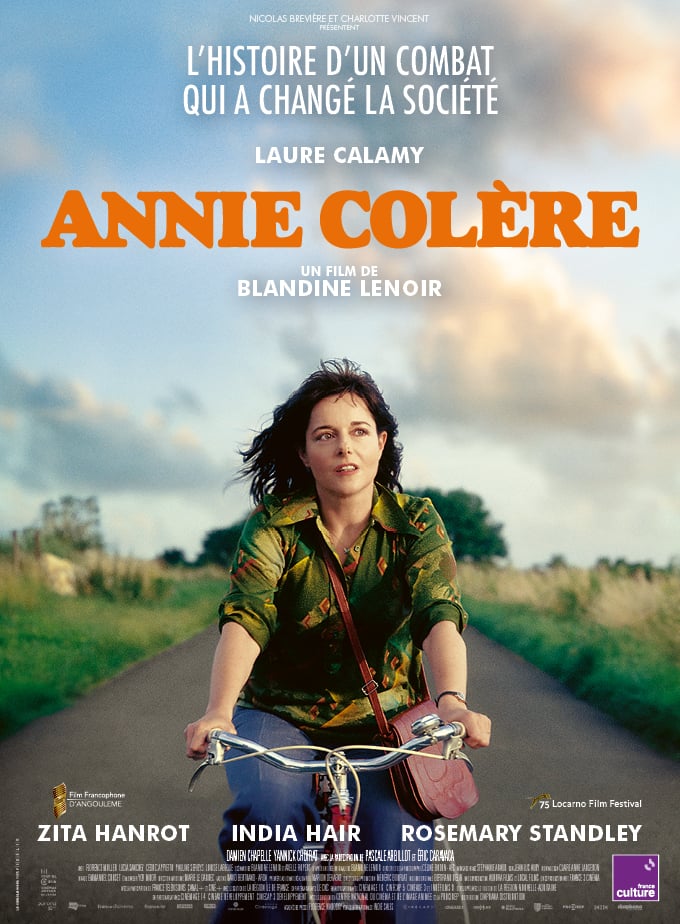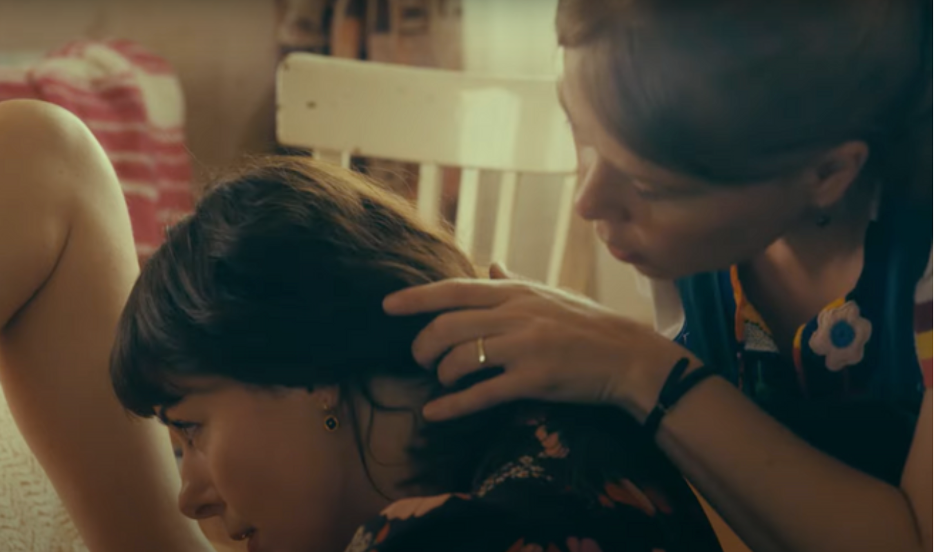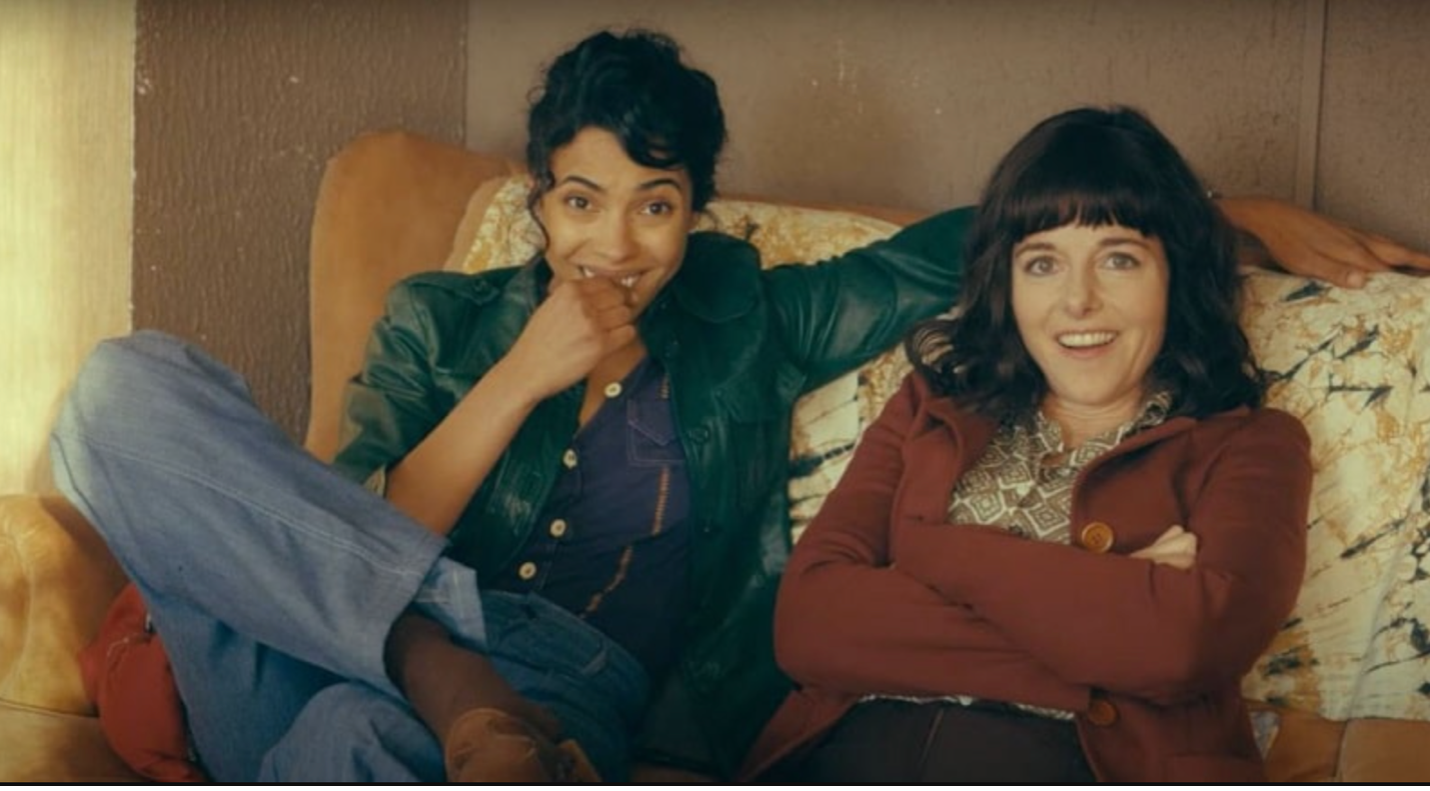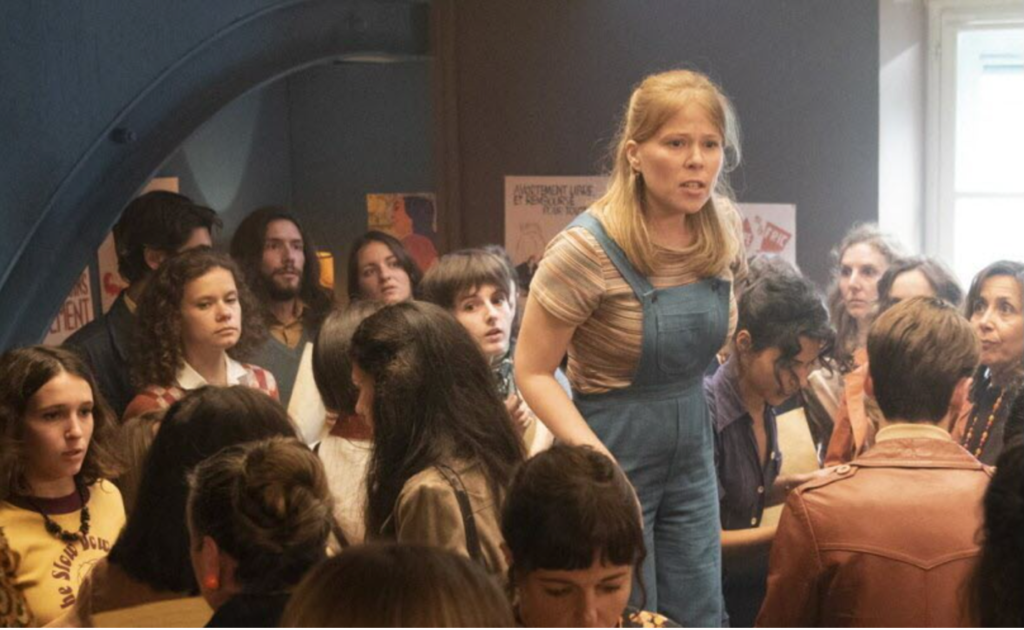Grace An, Oberlin College

The poster image of Annie colère (Blandine Lenoir, 2022) does not immediately evoke “abortion” or “reproductive politics,” but curiosity and movement for the eponymous protagonist, portrayed by actress Laure Calamy [Figure 1]. Riding her bicycle in the countryside, she faces the camera and searches the off-screen distance, perhaps seeking an unknown destination on the horizon. Annie riding her bicycle will be the dominant image of the entire film. Her bike transports her between life as wife and mother at home and her job in a mattress factory. Much to her surprise, it will also take her to hidden locations where she will undergo, support, and eventually perform illegal abortions during 1974, the year before the Assemblée Nationale passed the Veil Law (la loi du 17 janvier 1975 relative à l’interruption volontaire de grossesse), a piece of pivotal legislation that legalized abortion in France.
The regular presence of Annie’s bicycle shifts Annie colère from a story exclusively about abortion to one that follows the personal journey of an otherwise anonymous heroine of the Liberation Movement for Abortion and Contraception (MLAC) [1], through which civilians and activists took reproductive care into their hands. Via Annie and her friends, viewers learn how MLAC activists developed paramedical networks for French citizens who had been failed by medical establishments, conservative organizations, and the government since abortion was criminalized in 1920. Their engagement led to self-awakening, courage, and liberation for thousands of French women who fought for safe, legal abortion with their own bodies, and later for fulfillment as equal members of French society.
As many know, the Veil Law was named for Simone Veil, the Pantheonized Minister of Health under President Valéry Giscard d’Estaing from 1974 to 1979, as well as a survivor of the Holocaust and prolific writer. According to many scholars of and participants in the French reproductive rights movement, this was not a perfect law; it was unevenly practiced, neglectful of minors and foreigners, unreimbursed by la Sécurité sociale, and contingent upon another National Assembly vote in five years. Nevertheless, as Yvonne Knibiehler has argued, the Veil Law was the habeas corpus of women, marking a watershed for relations between the sexes. [2] Interestingly, director Lenoir does not pay homage to the stars of the movement for reproductive rights–neither to philosopher-writer Simone de Beauvoir nor to abortion lawyer-advocate Gisèle Halimi, nor even to Veil. Instead, she focuses on MLAC’s nameless soldiers: activist doctors who risked their careers by practicing illegal abortions, the women who trusted them (despite misinformation that sterility and decreased male pleasure were by-products of contraception), and especially the women who “accompanied” the abortions, by assisting providers during the procedure and providing comfort to abortion receivers.
In its founding charter of March 1973, MLAC committed to sexual education and information, and to the freedom of contraception and abortion that its comités locaux provided in Paris and over 150 towns and cities across France. MLAC overlapped with other groups that also fought for safer and more accessible abortions, including le Planning familial, le Mouvement de libération des femmes (MLF), and the Groupe Information Santé (GIS), which mobilized doctors influenced by Maoism and Michel Foucault, who were concerned with protecting patients’ rights against medical boards, medical institutions, and prison medical services. The abortions that MLAC performed were acts both medical and activist, in keeping with the petition that inspired the organization in the first place: the Manifeste des 331, published in the center-left news magazine Le Nouvel Observateur in February 1973 and signed by 331 doctors asserting that they had performed illegal abortions. That petition had taken its cue from another signature event in the reproductive rights movement in France: Le Manifeste des 343, also published in Le Nouvel Observateur but earlier in April 1971, when 343 women professed having undergone illegal abortions.
Through MLAC, women coordinated education, counseling, and logistics around abortion, while distributing contraceptive methods that each person chose in light of her individual needs. The “tendresse” between the women of Annie colère is indeed one of the film’s most touching aspects, consistent with MLAC’s own intimate mise-en-scène of the process “from support to intervention” [3] in the early 1970s. They sing songs to distract a woman undergoing an abortion, hold her hand to communicate strength and comfort, offer verbal encouragement and breathing advice to calm the abortion recipient’s nerves (instead of anesthesia to put her to sleep), and explain each step of the process in plain, gentle language. The patient could thus become a participant in her own process, thanks to the protagonists of the film and the actual MLAC community, whose work played an important role in the history of reproductive care.
The culture of MLAC was extraordinary given the dangers faced by its participants. After all, risk was essential to the change they sought. Early in the film, MLAC members Hélène (Zita Hanrot) and Monique (Rosemary Standley) insist on a crucial distinction regarding the abortions that Annie and two other nervous patients will receive: “illegal but not underground” (“illégal, mais pas clandestin”). In other words, they understand these abortions as a public form of civil disobedience that would hammer the final nail into the coffin of the 1920 law prohibiting abortion, which their compatriotes were already breaking every day. Such actions would declare the law obsolete, yet dangerous still, as it forces women to resort to unsafe methods such as the use of knitting needles, which Annie confesses to have done previously. At the same time, a minimum of secrecy protects MLAC from disruption by conservative anti-choice groups such as Laissez-les-vivre, and peacefully maintains counseling sessions (la permanence) in, say, the back room of a bookstore, as MLAC did at the time at its main Paris office on rue Buffon in the 5th arrondissement.

For their part, Annie and her friends share information at work but in hushed tones. And she only discusses abortion and sexual education with her daughter when the latter learns about her mother’s activist care from a friend who benefitted from it. The notion of taking matters into one’s hands assumes a heightened resonance in the film [Figure 2], first because it emphasizes the hands of care and political action in close-up and medium shots, and secondly because these women train themselves to assume responsibility for services they need but rarely receive from medical institutions governed by male or conservative medical boards. One vital difference created by MLAC is the occupation of abortion services away from medical power, or normative medicine, in the real and proverbial hands of these paramedical activists.
The notion of taking matters into one’s hands assumes a heightened resonance in the film, first because it emphasizes the hands of care and political action in close-up and medium shots, and secondly because these women train themselves to assume responsibility for services they need but rarely receive from medical institutions governed by male or conservative medical boards.
Annie colère also shows the new abortion method in action, “la méthode Karman,” named for the American doctor who discovered it in China and introduced it to feminists and activist doctors in actress Delphine Seyrig’s apartment in the Place des Vosges in August 1971. [4] While we hear characters explore their reproductive anatomy out loud, Lenoir does not show the process. Instead, she narrates the abortion process through the tools of abortion: viewers countenance the syringe, the cannula, and the bike pump while MLAC members explain their respective functions. The procedure lasts 10 to 15 minutes in real time, its rapidity claimed as an advantage of the method. What’s equally important is the method’s efficacy, low cost, simplicity, and ease, and its use in comfortable, private settings instead of hospitals. Such features articulated MLAC’s politics in action, leading to the characterization of the Karman method as une arme révolutionnaire and a novel manner of terminating pregnancy. The human labor of abortion, which was voluntary, made expanded access a priority and was in keeping with the non-remuneration of activist engagements; all that required payment were the inexpensive materials and some pain-relief medicine.
Curiously, the characters of Annie colère name the method as “American” despite established knowledge of its Chinese origins. I explain this narrative choice as one that frames the method as foreign with a belated arrival in France, which legalized abortion later than England, Holland, and Sweden [5], and perhaps as Lenoir’s effort to redirect attention from a first name in abortion lore (Karman) toward Annie and Hélène. What we also briefly learn (or remember) is that MLAC organized bus trips to London and Amsterdam when supply was insufficient to meet demand in France. They negotiated with abortion clinics in both cities to minimize cost and encouraged recipients to post banners declaring “J’AI AVORTÉ” on bus windows upon their return to Paris. According to Irène Jouannet, a filmmaker and a committed member of MLAC at the time, such actions were designed to “bring the scandal into the light” (46) [6], which further characterizes the implications of the ethos statement “illegal but not underground.”
Lenoir openly credits Lucile Ruault’s 800-page graduate thesis on MLAC as her principal source of information and often refers to documentaries on abortion from the 1970s, such as Regarde elle a les yeux grands ouverts, which Yann Masson co-wrote and co-directed with the MLAC chapter of Aix-en-Provence. The film observes life for MLAC members during a major court trial against abortion providers in March 1977, two years after the Veil Law. Another significant documentary was Histoires d’A by Charles Belmont and Marielle Issartel in 1975; re-released in 2022 on DVD, this film provides exciting footage of the activity of MLAC chapters in Paris during the last couple of years leading to the Veil Law in 1975. What all of these films address is the precipitous increase of demand for MLAC abortions after the publication of petitions such as the Manifeste des 343 and the Manifeste des 331, and all depict the lives of women and their families during challenging moments of (in)decision.

If there is one vedette of the reproductive rights movement who does receive attention from Lenoir, it is the aforementioned actress Delphine Seyrig. Only once does Lenoir use found footage: a clip from an October 1972 episode of the televised talk show Actuel 2, when Seyrig broke through taboo and shame to speak truth and rage to the general public, and the fellow guests who were seated at the literal and proverbial table as personifications of medical and state power. [7] Annie and her friend Hélène draw inspiration from this televised moment, which culminates in Seyrig’s exclamation:
You sitting there are all men. There are millions of women in France, and here we are discussing whether to give them freedom, whether they are capable of taking responsibility. In general, we are small, unintelligent beings, like little dogs that one must take for a walk at this time or that, and we aren’t given our autonomy, our own bodily autonomy. [8]
Delphine seyrig
The reaction shot focusing on Annie and Hélène (Figure 3) registers the impact of Seyrig’s words in living rooms across the country. It bears mentioning that the 1972 episode occurs during a film that dates itself to 1974, but this minor anachronism becomes moot when considering the impact of the scene on the audience for Annie colère at the Arlequin cinema in Paris on November 25, 2022. The entire salle erupted in cheers. Another allusion to the feminist actress takes the form of a secondary character who Lenoir has described as “a provincial version of Delphine Seyrig.” [9] That character lends her private residence as a comfortable setting for abortions for which she helped pay, as did Seyrig and other women, such as Simone de Beauvoir and filmmaker Agnès Varda, in their day. Ventriloquizing Seyrig’s words from a 1985 televised interview, the character explains her aim to help women transform “shameful subjects into noble ones.” [10]
Like Seyrig, Lenoir hopes to give concrete cinematographic and cultural existence to a movement that has hovered in the margins of history. She also acknowledges the dignity and courage of the collective struggle for a right that many of us took for granted before June 2022, when the United States Supreme Court overturned the decision in Roe v. Wade that legalized abortion in the US in 1973. The concrete nature of the film materializes in its attention to objects, especially the implements of abortion mentioned above, housed in a repurposed suitcase and so offering yet another travel metaphor alongside the bicycle. When Annie assembles her own suitcase–her clandestine counter-medical bag–this specialized tool kit signals her initiation to a higher level of participation, as well as competency. Common in every French town with a MLAC chapter at that time, the suitcase evokes the shared ethos of these characters, one of whom declares, “one must relay and pass onward what is learned.” [11] Another film object is the Italian coffeemaker that Annie’s husband brings home from a trip to Italy. While her kids delight in the exciting Italian souvenirs their father has brought them, Annie is resigned to the utilitarian, unromantic nature of hers. Yet pity Annie not! The cafetière will find its purpose in a humorous transfer from its intended context to one the husband did not anticipate, replacing the broken coffeemaker at the MLAC permanence. In so doing, it maps Annie’s transition from the life she has known to the one she will discover.
Other household objects will be adopted by Annie’s family as her commitment to MLAC increasingly absent her from home. Her husband will learn how to use kitchen pots, her children will learn how to do laundry–the latter in a scene that portrays Annie and her radiantly smiling children folding sheets from the clothesline under resplendent sunlight, suggesting the children’s ability to adapt to their mother’s prise de conscience and consequent changes in family life that include Annie’s choice to not attend an important wedding because of a woman in need. And let us not forget the mattresses that Annie helps assemble in the factory early in the film. Pins clenched by her teeth are pushed by strong hands into stiff fabric that will ultimately contain stuffing thanks to sheer human will and strength, for it is not a machine but a woman who must contend with one mattress after another. Annie conquers the resistant materials with her entire body. Not only do objects and physical labor belong to one continuous landscape–that of the life of a working-class woman in an unnamed town in provincial France–but they reinforce the film’s tactility. The film emphasizes bodies in action, with close-ups, extreme and medium, that heighten the spatial intimacy between the characters Who are shot in tight spaces near the surface of the screen, as if in co-extension with our space in the cinema [Figure 4].

Coincidentally, Annie colère was made at the same time as the adaptation of Annie Ernaux’s L’événement (Audrey Diwan, 2021), and released not long after the awarding of the Nobel Prize for Literature to Ernaux. Less fortunately, its release also coincides with that of the American counterpart Call Jane (Phyllis Nagy, 2022) with which it competes for international distribution. In fact, it is because of Call Jane that Annie colère might never be distributed in the U. S. or England, beyond the film festival circuit. It is important to take note of the inability of the international film market to make room for two narrative films about underground abortion networks in two industrialized countries around the same time. Such limits are discouraging in a post-Dobbs world that revealed just how vulnerable reproductive rights have long been in the U. S., hanging on a single Supreme Court decision that was never ratified legislatively, like the Veil Law in France. While the decision not to distribute Annie colère in the U. S. and England could be reversed, against many odds, the international film market has shown itself complicit with ongoing challenges to les acquis féministes–rights that were hard won and yet perpetually on the verge of disappearing. We are reminded that box office figures do not correlate with cultural and political significance either, for the supposed non-success of Diwan’s L’événement in the U. S., according to the film’s distributor, discouraged an American release of Annie colère. Finally, it is important to acknowledge the challenges faced by French women filmmakers, limited as most of them are to small budgets despite proven records in filmmaking. Lenoir’s modest budget excluded scenes of large public demonstrations, as well as the use of found footage except for Seyrig’s Actuel 2 appearance. And yet, she has produced a carefully focused human story of the alternative paramedical culture that MLAC created for themselves and for the people who benefitted from it.
Efforts for the movement in 1974 and the film about it in 2022 demonstrate how disruption and disobedience remain necessary for women to get the reproductive care they need. This struggle does not end with the film. It didn’t even end with the Veil Law in 1975, which Annie and some of her friends fear might erase the very culture of “tendresse” that they created together. It remains essential to assert that abortion narratives should never be reduced to the ending of pregnancies, nor to murder. MLAC’s culture of reproductive care leads the film’s characters toward new communities, new senses of purpose, perhaps new lives. Scholars researching this movement understand how abortion politics drew many women out of the proverbial woodwork, the majority of whom had never imagined themselves in roles other than those of wife and mother, much less as leaders of like-minded friends and colleagues. Annie, through whom Lenoir remembers these very women, will finish the film away from her town, entering what looks like a medical or nursing school. In the last shot, her face glows with nascent self-knowledge on the horizon of a new life chapter. Lenoir has cogently and lovingly reclaimed a place in memory for the struggle beyond legalized abortion toward true reproductive health care, undertaken at great risk yet redefined by thousands of women who participated in MLAC in the early 1970s. Annie colère presents a portrait of the épanouissement of an awakened woman who channels her colère into la naissance d’une liberté. [12]
Blandine Lenoir, Annie Colère (2022) France. 119 min. Color. Diaphana Films.
Bibliography
Charles Belmont and Marielle Issartel, Histoires d’A (1975) France. 85 min. B&W. L’éclaireur.
Audrey Diwan, L’événement (2021) France. 100 min. Color. Wild Bunch Films.
Lucile Ruault, Le spéculum, la canule et le miroir. Les MLAC et mobilisations de santé des femmes, entre appropriation féministe et propriété médicale de l’avortement (France, 1972-1984). Doctoral dissertation, Université de Lille, 2017.
Xavière Gauthier, Naissance d’une liberté. Contraception, avortement : le grand combat des femmes au XXe siècle (Paris: Robert Laffont, 2002).
Irène Jouannet, Mes années MLAC. Petite chronique d’une grande conquête (Paris: Éditions du Croquant, 2020.)
Yann Masson and Collectif de femmes MLAC, Regarde, elle a les yeux grands ouverts (1982), France. 77 min. Color. Les Films Grains de Sable.
Bibia Pavard, Si je veux, quand je veux : contraception et avortement dans la société française (1956-1979) (Rennes: Presses universitaires de Rennes, 2012).
Françoise Picq, Libération des femmes. Les années-mouvement (Paris: Seuil, 1993).
Agnès Varda, L’une chante l’autre pas (1976) France. 120 min. Color. Ciné-Tamaris.
Notes
[1] Le Mouvement de Libération pour l’avortement et la contraception.
[2] Michelle Perrot, Mon histoire des femmes (Paris: Seuil, 2006).
[3] « de l’accompagnement à l’intervention. »
[4] Since 2008, Chinese, Australian, and British obstetricians have sought to earn recognition for the pioneering research paper on this new method in China, on the 50th anniversary of its 1958 publication in The Chinese Journal of Obstetrics and Gynaecology. Although the original paper written by Yuantai Wu and Xianzhen Wu, who “invented” the method, remains unverifiable, it was the first to earn world attention for the method. See Rebecca Coombes, “Obstetricians Seek Recognition for Chinese Pioneers of Safe Abortion,” BMJ 336, no. 7658 (2008): 1332–33, https://doi.org/10.1136/bmj.a400.
[5] Bibia Pavard contextualized the naming of the method after Karman by acknowledging its Chinese origins and forwarding that Karman’s main contribution was to promote it in Western countries while improving the cannula (164). Other sources refer to Karman as the inventor of the cannula.
[6] « [faire] éclater le scandale au grand jour. »
[7] The guests included Lucien Neuwirth, the National Assembly member who drafted the namesake law that legalized contraception in France in 1967.
[8] « Vous êtes tous des hommes, là. Il y a des millions de femmes en France, et on est en train de discuter de savoir si on va leur donner la liberté, si elles sont capables de prendre la responsabilité. En somme, nous sommes des petites personnes inintelligentes, comme des petits chiens, qu’on doit promener de telle heure à telle heure, et on ne nous donne pas notre autonomie. L’autonomie de notre corps. »
[9] Conversation with Blandine Lenoir, November 19, 2022. I thank her for our conversations about her film.
[10] « des sujets honteux en des sujets nobles. » Aujourd’hui la vie (Antenne 2, May 14, 1985), with fellow guests Simone de Beauvoir, Christine Delphy, Anne Zelensky, and Annie Sugier.
[11] « il faut transmettre ce qu’on apprend. »
[12] I acknowledge the importance of Xavière Gauthier’s scholarship in my research.
